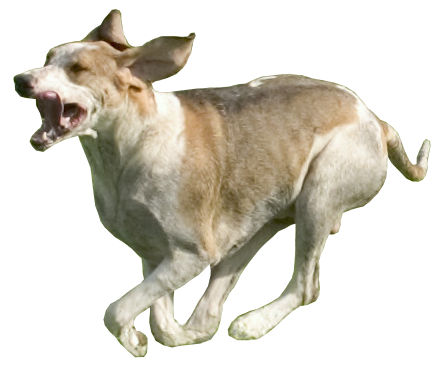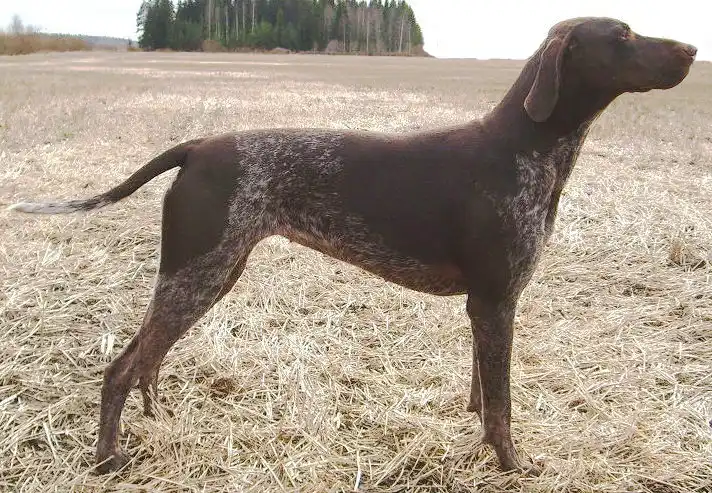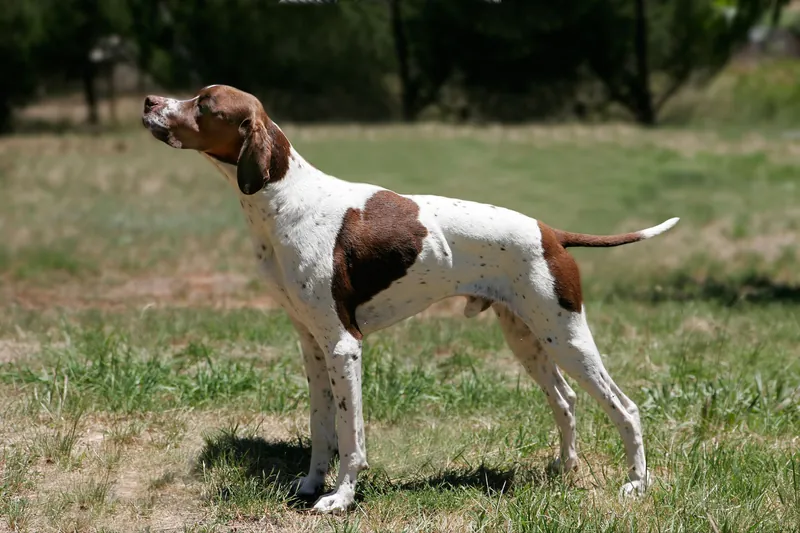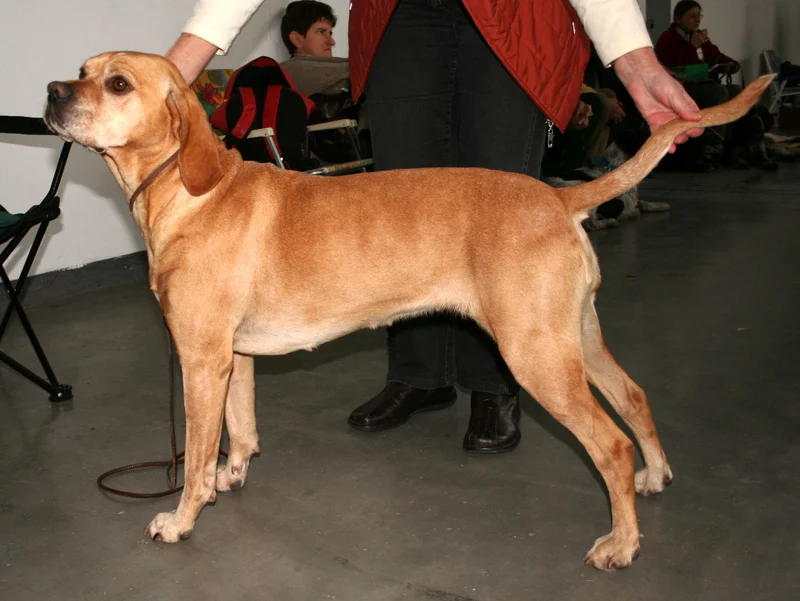German Wirehaired Pointer
The German Wirehaired Pointer is a versatile hunting dog known for its rugged appearance, intelligence, and loyalty. With a distinctive wiry coat, they thrive on exercise and human companionship, making them excellent family pets and hunting partners.
Overview
🐕Breed Overview
✨Key Traits
💡What Makes German Wirehaired Pointer Special
The German Wirehaired Pointer is characterized by its versatility as a hunting dog, capable of tracking, pointing, and retrieving game in various terrains. Their distinctive wiry coat not only provides protection but also requires minimal grooming, making them relatively low-maintenance.
They are known for their strong work ethic and determination, often excelling in field trials and hunting competitions. Their affectionate nature and loyalty to their families make them excellent companions, while their intelligence allows them to learn commands and tasks quickly.
However, their stubbornness can pose challenges during training, requiring a consistent and patient approach. Overall, the GWP is a breed that combines hunting prowess with a loving temperament, making them a cherished addition to active households.
The German Wirehaired Pointer (GWP) is a medium to large-sized dog known for its rugged appearance and exceptional hunting abilities. Developed in Germany in the late 19th century, this breed was created to be a versatile hunting companion, capable of tracking, pointing, and retrieving game in various terrains. With a distinctive wiry coat that is both weather-resistant and water-repellent, the GWP is well-suited for outdoor activities.
Their affectionate and intelligent nature makes them not only excellent hunters but also loyal family pets. They thrive on human companionship and require regular exercise to keep them happy and well-behaved. Known for their strong work ethic, these dogs excel in field trials and various canine sports, showcasing their agility and intelligence.
The GWP is a breed that requires an active lifestyle, making them ideal for outdoor enthusiasts and families who enjoy spending time in nature. With proper training and socialization, they can adapt well to family life, interacting positively with children and other pets. However, their high energy levels and strong prey drive necessitate a committed owner who can provide the necessary exercise and mental stimulation.
Overall, the German Wirehaired Pointer is a remarkable breed that combines hunting prowess with a loving and loyal temperament, making them a cherished companion for those who appreciate their unique qualities.
🎉Fun Facts
German Wirehaired Pointers have a strong prey drive, which can make them less suitable for homes with small pets.
GWPs are known for their playful nature and often enjoy participating in family activities, making them great family pets.
The German Wirehaired Pointer is known for its exceptional tracking abilities, often excelling in field trials and hunting competitions.
They have a unique wiry coat that provides protection against harsh weather and rough terrain, making them ideal hunting companions.
This breed is highly trainable and eager to learn, often thriving in obedience and agility training.
Breed Characteristics
Family & Friends
Good Behavior
Get Up & Go
Household Harmony
Temperament & Personality
✨Key Traits
🐕Core Temperament
The German Wirehaired Pointer is known for its friendly and loyal temperament. They are affectionate with their families and enjoy being part of household activities. While they can be aloof with strangers, they are not aggressive and can be trained to be more sociable.
Their energetic nature means they require regular exercise and mental stimulation to stay happy and well-behaved. They are intelligent and eager to please, making them responsive to training. However, their strong prey drive and independent spirit may lead them to wander if not properly supervised.
Overall, they are a versatile breed that thrives in active households.
💫Personality Profile
The German Wirehaired Pointer is a lively and affectionate breed that thrives on human companionship. They are known for their intelligence and eagerness to learn, making them responsive to training.
While they are friendly and loyal to their families, they can be aloof with strangers, necessitating early socialization. Their energetic nature means they require regular exercise and mental stimulation to prevent boredom and destructive behaviors.
GWPs are playful and enjoy engaging in activities with their owners, making them excellent companions for active families. However, their strong prey drive may lead them to chase smaller animals, so supervision is essential around pets like cats.
🔊Vocal Tendencies
The German Wirehaired Pointer has a moderate noise level, typically barking to alert their owners of strangers or unusual activity. While they are not excessive barkers, they may vocalize when excited or during play.
Their vocalizations can include barking, whining, and howling, particularly when they are seeking attention or feeling bored. Early training and socialization can help manage their barking tendencies, ensuring they are well-behaved in various situations.
Overall, they are not known for being overly noisy, but their alertness can lead to occasional barking.
Affection & Social Traits
Energy & Activity
Communication Style
Care Requirements
🏃♂️Exercise Requirements
Daily Exercise
The German Wirehaired Pointer (GWP) is a highly energetic breed that requires a significant amount of exercise to maintain its physical and mental well-being. Ideally, they should engage in at least 60 to 90 minutes of vigorous activity daily. This can include activities such as running, hiking, swimming, and playing fetch.
They thrive in environments where they can explore and utilize their natural hunting instincts. Puppies require shorter bursts of exercise, around 30 minutes, but should be allowed to play freely to develop their muscles and coordination. Adult dogs need consistent exercise to prevent boredom, which can lead to destructive behaviors.
Senior dogs may require less intense exercise but still benefit from regular walks and mental stimulation through games and training. Regular exercise helps manage their weight, supports cardiovascular health, and contributes to their overall happiness and behavior. Insufficient exercise can lead to hyperactivity, anxiety, and various health issues.
Preferred Activities
🏠Living & Adaptability
Space Requirements
The German Wirehaired Pointer is best suited for homes with ample outdoor space, such as a large yard or access to open fields. They are not ideal for apartment living due to their high energy levels and need for space to roam and explore.
In smaller living situations, owners must commit to providing daily exercise and mental stimulation through structured activities. A securely fenced yard is essential to prevent them from wandering, as they have a natural inclination to roam.
Without adequate space and stimulation, they may exhibit destructive behaviors or anxiety.
Climate Preference
🍲Feeding Guide
Schedule
Food Types
Portion Size
Special Nutritional Needs
German Wirehaired Pointers may benefit from a diet rich in protein and healthy fats to support their active lifestyle. It's important to monitor their weight and adjust food portions accordingly, especially if they are less active. Some individuals may have food sensitivities, so it's advisable to consult with a veterinarian for specific dietary recommendations.
✨Grooming Requirements
Grooming Overview
The grooming needs of the German Wirehaired Pointer are relatively low compared to other breeds, but they do require regular maintenance to keep their wiry coat in good condition. Brushing once a week is typically sufficient to remove loose hair and debris.
Hand-stripping may be necessary occasionally to maintain the coat's texture and appearance. Bathing should be done as needed, particularly after outdoor activities.
Regular checks of the ears, teeth, and nails are also important to ensure overall health. Their low shedding coat makes them a suitable choice for those who prefer a cleaner home environment.
Care Schedule
Brush weekly; bathe as needed; trim nails every 2-4 weeks.
Health Profile
⚕️Health Care
Regular health care is vital for the longevity of the German Wirehaired Pointer. Routine veterinary check-ups, vaccinations, and preventive treatments for parasites are essential to maintain optimal health.
Early detection of health issues through regular examinations can lead to more effective management and treatment. Owners should also focus on dental care, as dental diseases can impact overall health.
Providing a balanced diet and ensuring proper exercise are critical components of health care that contribute to a longer lifespan.
Health Issues Overview
⏳Average Lifespan
Genetic Factors
Genetics play a crucial role in the lifespan of the German Wirehaired Pointer. Responsible breeding practices that prioritize health and genetic diversity can help reduce the incidence of hereditary health issues.
Potential owners should seek reputable breeders who conduct health screenings for common conditions such as hip dysplasia and hypothyroidism. Understanding the genetic background of a dog can provide insights into potential health risks and help owners make informed decisions regarding their care.
Living Conditions
The lifespan of a German Wirehaired Pointer can be influenced by various environmental factors. Dogs living in active households with ample opportunities for exercise and mental stimulation tend to live longer, healthier lives.
Regular veterinary care, a balanced diet, and a safe living environment contribute significantly to their overall well-being. Exposure to harsh weather conditions without adequate shelter can negatively impact their health.
Additionally, social interactions with humans and other pets can enhance their emotional health, promoting longevity.
🏥Common Health Issues
Hip Dysplasia
Warning Signs
🔬Diagnosis
X-rays and physical examination by a veterinarian.
💊Treatment
Surgical options or medication for pain management.
📝Management Tips
Maintain a healthy weight, provide joint supplements, and avoid excessive jumping or strenuous activities.
Hypothyroidism
Warning Signs
🔬Diagnosis
Blood tests to measure thyroid hormone levels.
💊Treatment
Lifelong medication to manage hormone levels.
📝Management Tips
Regular monitoring and administration of thyroid hormone replacement therapy.
Elbow Dysplasia
Warning Signs
🔬Diagnosis
X-rays and physical examination by a veterinarian.
💊Treatment
Surgical intervention may be necessary in severe cases.
📝Management Tips
Weight management and controlled exercise to reduce stress on joints.
Gastric Torsion (Bloat)
Warning Signs
🔬Diagnosis
Physical examination and imaging studies.
💊Treatment
Emergency surgery is often required.
📝Management Tips
Feed smaller, more frequent meals and avoid vigorous exercise after eating.
Von Willebrand Disease (vWD)
Warning Signs
🔬Diagnosis
Blood tests to assess clotting ability.
💊Treatment
Management through careful monitoring and veterinary guidance.
📝Management Tips
Avoid situations that may lead to bleeding; regular veterinary check-ups.
🛡️Preventive Care
🔬Hip Evaluation
Hip Evaluation: Assesses the hip joints for dysplasia and other abnormalities.
📅 Annually, starting at 2 years of age.
🔬Thyroid Function Test
Thyroid Function Test: Evaluates thyroid hormone levels to detect hypothyroidism.
📅 Every 1-2 years, especially in older dogs.
🔬Elbow Evaluation
Elbow Evaluation: Checks for elbow dysplasia and other joint issues.
📅 Annually, starting at 2 years of age.
🔬Cardiac Evaluation
Cardiac Evaluation: Monitors heart health and detects any potential issues.
📅 Every 1-2 years, especially in older dogs.
🔬Eye Examination
Eye Examination: Screens for hereditary eye conditions.
📅 Every 1-2 years, especially in older dogs.
Training
🧠Intelligence & Trainability
💪Work Drive
The German Wirehaired Pointer has a strong work drive and thrives when given tasks to complete. They excel in activities that challenge their physical and mental abilities, such as hunting, tracking, and participating in field trials.
Engaging them in regular exercise and providing opportunities for them to use their natural instincts is essential for their well-being. Without sufficient mental and physical stimulation, they may become bored and exhibit destructive behaviors.
Activities like agility training, obedience competitions, and scent work can help fulfill their need for mental engagement.
⚠️Training Considerations
The German Wirehaired Pointer can exhibit stubbornness and a strong will, which may pose challenges during training. They require a handler who is consistent, patient, and experienced in dog training.
Common behavioral challenges include their tendency to roam and their high prey drive, which can lead them to chase small animals. To overcome these challenges, early socialization and obedience training are essential.
Engaging them in activities that channel their energy, such as agility or tracking, can also help mitigate behavioral issues. Providing mental stimulation through puzzle toys and interactive games is crucial to prevent boredom and destructive behavior.
📝Training Tips
Training a German Wirehaired Pointer requires a firm yet positive approach. Utilizing reward-based training methods, such as treats and praise, can enhance their learning experience.
Consistency is key; commands should be reinforced regularly, and training sessions should be kept short and engaging to maintain their interest. Socialization with other dogs and people from a young age is vital to develop their confidence and reduce their natural aloofness towards strangers.
Incorporating activities that align with their hunting instincts, such as scent work or retrieving games, can make training more enjoyable and effective.
History & Heritage
📜Origin Story
The origins of the German Wirehaired Pointer can be traced back to the late 1800s in Germany, where hunters sought a versatile dog capable of tracking, pointing, and retrieving game across various terrains. Breeders aimed to develop a rugged, all-purpose hunting dog that could withstand harsh weather conditions and navigate dense underbrush.
The breed was created through the careful selection of existing breeds, including the Wirehaired Pointing Griffon and the Pudelpointer, resulting in a dog that could work closely with hunters on foot. The GWP quickly became popular among hunters for its intelligence, loyalty, and ability to perform a wide range of tasks.
By the mid-20th century, the breed had established itself as a leading gun dog in Germany and gained recognition in other countries, including the United States.
⏳Development History
The German Wirehaired Pointer was developed in the late 19th century through the careful mixing of several breeds, including the Griffon, Deutscher Stichelhaar, Deutscher Kurzhaar, and the Pudelpointer. The goal was to create a medium to large-sized dog with a weather-resistant coat capable of hunting various game in different terrains.
The breed gained recognition in Germany during the 1920s and was officially recognized by the American Kennel Club in 1959. Over the years, the GWP has maintained its status as a versatile hunting dog, excelling in both upland and waterfowl hunting, while also becoming a cherished family companion.
🛡️Purpose & Historical Role
Originally bred as a hunting dog, the German Wirehaired Pointer was designed to track, point, and retrieve game in various environments. Its versatility allowed it to excel in hunting both feathered and furred game, making it an invaluable companion for hunters.
The breed's strong work ethic and intelligence also made it suitable for roles beyond hunting, including as a watchdog and family companion. Today, the GWP is recognized for its abilities in field trials, obedience competitions, and as a loyal family pet.
🏺Cultural Significance
The German Wirehaired Pointer holds a significant place in German hunting culture, developed in the late 19th century to meet the needs of hunters seeking a versatile and rugged companion. The breed's ability to work in diverse terrains—from dense forests to open fields—made it a favorite among hunters.
Its popularity has spread beyond Germany, with the breed recognized for its exceptional hunting skills and loyalty, making it a beloved family pet and working dog in various countries. The GWP's unique appearance and capabilities have also led to its representation in popular culture, showcasing its role as a reliable hunting partner and affectionate family member.
Conservation Status
This breed is well-established with healthy population numbers.









